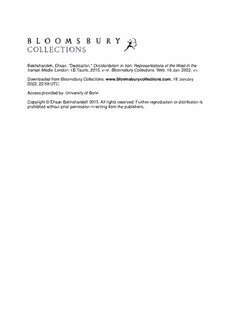
Occidentalism in Iran representations of the West in the Iranian media. PDF
Preview Occidentalism in Iran representations of the West in the Iranian media.
Bakhshandeh, Ehsan. "Dedication." Occidentalism in Iran: Representations of the West in the Iranian Media. London: I.B.Tauris, 2015. v–vi. Bloomsbury Collections. Web. 18 Jan. 2022. <>. Downloaded from Bloomsbury Collections, www.bloomsburycollections.com, 18 January 2022, 22:59 UTC. Access provided by: University of Bonn Copyright © Ehsan Bakhshandeh 2015. All rights reserved. Further reproduction or distribution is prohibited without prior permission in writing from the publishers. I dedicate this book to Professor Mohammad Mehdi Forqni, founder of Iran’s first College of Communication and outstanding researcher of journalism and media studies Bakhshandeh, Ehsan. "List Of Illustrations." Occidentalism in Iran: Representations of the West in the Iranian Media. London: I.B.Tauris, 2015. viii. Bloomsbury Collections. Web. 18 Jan. 2022. <>. Downloaded from Bloomsbury Collections, www.bloomsburycollections.com, 18 January 2022, 22:59 UTC. Access provided by: University of Bonn Copyright © Ehsan Bakhshandeh 2015. All rights reserved. Further reproduction or distribution is prohibited without prior permission in writing from the publishers. LIST OF ILLUSTRATIONS Figure 1.1. One definition of Occidentalism using similar words. Source: author. 14 Figure 6.1. Conservatism triangle of principles. Source: author. 97 Figure 8.1. Front page of Today’s Man weekly newspaper, 7 April 1944. Source: Amin (2001). 127 Figure 8.2. A cartoon from The Fire weekly newspaper, 22 April 1944. Source: Amin (2001). 128 Bakhshandeh, Ehsan. "List Of Tables." Occidentalism in Iran: Representations of the West in the Iranian Media. London: I.B.Tauris, 2015. ix–x. Bloomsbury Collections. Web. 18 Jan. 2022. <>. Downloaded from Bloomsbury Collections, www.bloomsburycollections.com, 18 January 2022, 22:59 UTC. Access provided by: University of Bonn Copyright © Ehsan Bakhshandeh 2015. All rights reserved. Further reproduction or distribution is prohibited without prior permission in writing from the publishers. LIST OF TABLES Table 4.1. An Anglo–Persian chronology up to 1925. Source: Denis Wright, The Persians amongst the English: Episodes in Anglo-Persian History (London: I.B.Tauris, 1985), pp. 216–20. 53 Table 7.1. Number of Iranian press and news agencies in 2007. Source: author. 117 Table 7.2. Number of Iranian press based on publication period. Source: author. 117 Table 7.3. Number of Iranian press based on distribution range. Source: author. 118 Table 7.4. Number of employees in the Iranian press and news agencies. Source: author. 118 Table 7.5. Number of employees in the Iranian press and news agencies based on gender. Source: author. 118 Table 7.6. Number of employees in the Iranian press and news agencies based on level of education. Source: author. 119 Table 7.7. Number of employees in the Iranian press and news agencies based on type of contract. Source: author. 119 x OCCIDENTALISM INIRAN Table 7.8. Number of employees in the Iranian press and news agencies based on job experience. Source: author. 119 Table 8.1. Front-page headline issues in major Iranian newspapers. Source: author. 132 Table 8.2. Editorial issues in major Iranian newspapers. Source: author. 132 Table 8.3. Foreign news issues in major Iranian newspapers. Source: author. 133 Table 8.4. Place of the event covered in the news in major Iranian newspapers. Source: author. 133 Bakhshandeh, Ehsan. "Introduction." Occidentalism in Iran: Representations of the West in the Iranian Media. London: I.B.Tauris, 2015. 1–8. Bloomsbury Collections. Web. 18 Jan. 2022. <http://dx.doi.org/10.5040/9780755609017.0006>. Downloaded from Bloomsbury Collections, www.bloomsburycollections.com, 18 January 2022, 22:59 UTC. Access provided by: University of Bonn Copyright © Ehsan Bakhshandeh 2015. All rights reserved. Further reproduction or distribution is prohibited without prior permission in writing from the publishers. INTRODUCTION With the election of Hassan Rouhani as the president of the Islamic RepublicofIranin2013,ordinaryIraniancitizens’hopesforabetterlife andrelieffromtheireconomichardshipgrew.Daysbeforetheelections, mytaxidriverjokedwithme,inthePersianlanguage,that‘Prideresid be Xantia, Mahdi biya Mahdi Biya’, which literally means the price of the ‘Pride’, a cheap low-class sedan produced by Iran and sold at about 80 million rials in 2010, had increased to the price of the Xantia, an expensivehigh-classcarmadebyPeugeotandtradedat200millionrials in2010,andnowitwastimeforHazratMahdi,thetwelfthShi‘iaImam, to reappear and come out of hiding (to end injustice and punish criminals).AfterPresidentRouhani’selectionthesametaxidrivertoldme that‘RouhaniisgoingtorestorerelationswiththeWestandwecanask Hazrat Mahdi to remain hidden!’ The driver actually meant conditions wouldimprove andthere was no need for the Imamtore-appear. The issue of relations between Iran and the West, particularly the United States, has always been a hot topic, especially during the elections in both Iran and the United States. Ronald Reagan won the 1981 elections and became the fortieth US President shortly after IranreleasedAmericanhostages.Thirty-twoyearslater,HassanRouhani became the seventh president of the Islamic Republic of Iran after he reportedly called, in one of his election campaigns in the Sharif University of Technology, for direct talks with the United States as ‘Americansaretheso-calledKadkhoda[chiefofthevillage],therefore,if we deal with the Kadkhoda, it would be easier for us to deal with someonewithalowerposition.’1Helaterdeniedtheremarksbuthada
